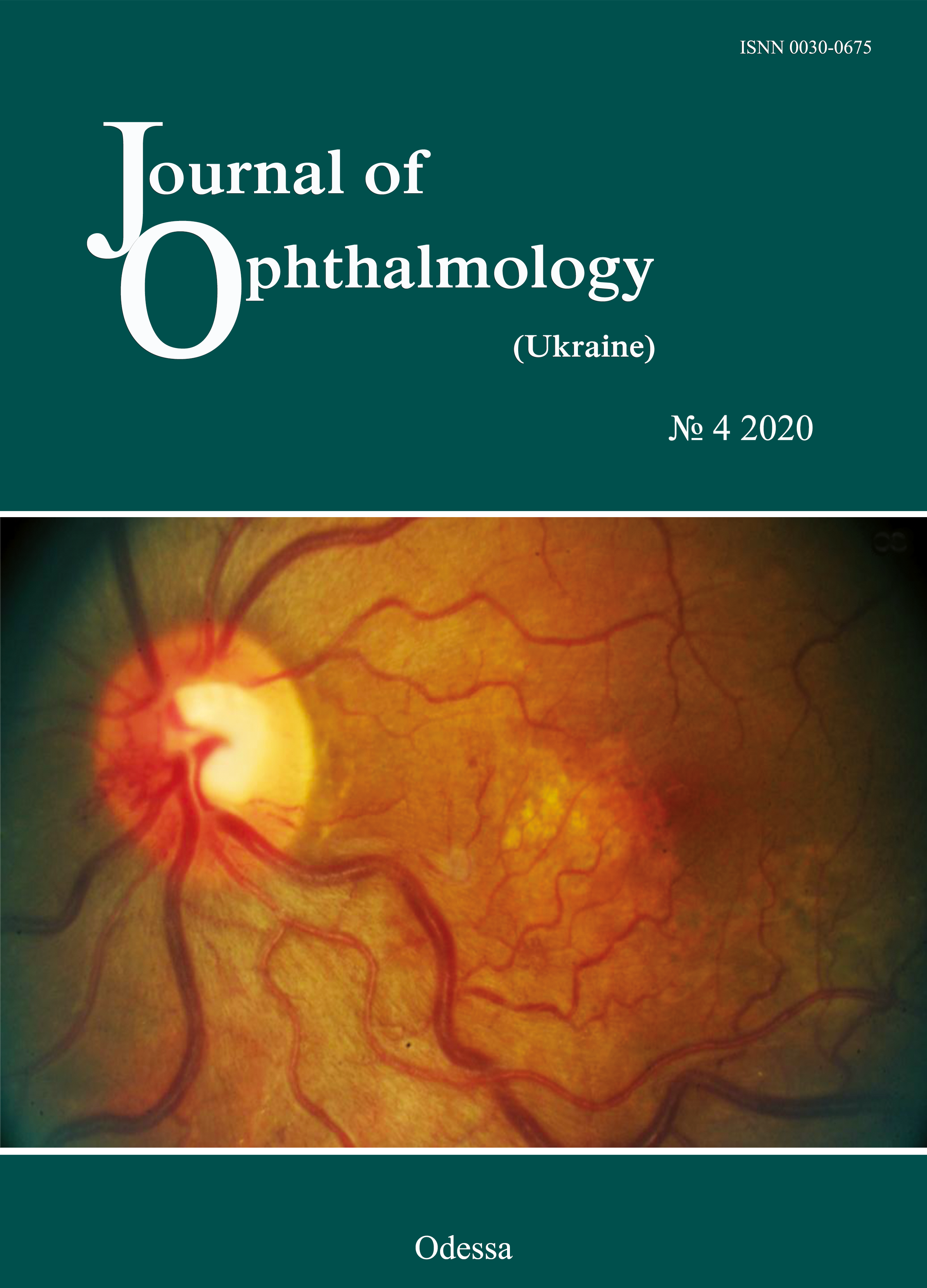Ultrastructural changes in the rabbit retina after various one-time doses of intravitreal melphalan
DOI:
https://doi.org/10.31288/oftalmolzh202045055Keywords:
intravitreal chemotherapy, melphalan, electron microscopy, retina, experimentAbstract
Background: Intravitreal chemotherapy (IVC) has become a common eye-preserving treatment for retinoblastoma (RB). However, there are still unsolved issues with regard to dosage of the cytostatic agent, its ultrastructural effects on healthy retinal cells, and late complications of the therapy.
Purpose: To identify and assess ultrastructural changes in the rabbit retina after various one-time doses of intravitreal melphalan.
Material and Methods: Six eyes of three Chinchilla rabbits (age, 5–6 months; weight, 2.5–3 kg) underwent clinical and electron miscroscopy examination. Both eyes of animals ##1, 2 and 3 received a single dose of intravitreal melphalan of 5, 10 and 20 ?g, respectively. Intravitreal injection was performed in a standard manner. The eyes were enucleated 4 weeks after injection. After enucleation, material for histology was taken in a routine manner and examined in a PEM-100-01 electron microscope.
Results: Intravitreal injection of various doses of melphalan had no general toxic effect on the animals. No retinal hemorrhage, vitreous hemorrhage, retinal tear or detachment was observed at all follow-up points, regardless of how large an intravitreal dose of melphalan was administered. No complications were observed postoperatively. Throughout a follow-up period of 4 weeks, there were no focal fundus changes in the eyes that received a single intravitreal injection of 5 ?g melphalan. In the eyes that received a single intravitreal injection of 10-?g or 20-?g melphalan, we noted a range of focal fundus changes from as mild as a few small isolated sites of slight depigmentation to as severe as pigment redistribution with the emergence of brighter and greater depigmentation regions in the retina. Ultrastructural changes corresponded to ophthalmoscopic changes. Electron microscopy revealed destructive changes in the retinal pigment epithelium (RPE), photoreceptors, and M?ller cells of the rabbit retina.
The minimum structural changes in the RPE and photoreceptor cells were seen after an injection of the smallest dose (5 ?g melphalan). After a 10-?g or 20-?g one-time dose of intravitreal melphalan, we observed severe changes (such as cell swelling, hypertrophy, destruction and disintegration) in retinal cells, disorganized retinal layers with loss of typical ultrastructural features, gliosis and necrosis.
Conclusion: On the basis of our findings, we can conclude that intravitreal melphalan is relatively safe when administered as a one-time 5-?g injection, and minimally toxic when administered as a one-time 10-?g injection. However, when administered as a one-time 20-?g injection, it resulted in severe changes such as gliosis and necrosis in retinal cells.
References
1.Edelhauser HF, Rowe-Rendleman C, Robinson M, et al. Ophthalmic Drug Delivery Systems for the Treatment of Retinal Diseases: Basic Research to Clinical Applications. Invest Ophthalmol Vis Sci. 2010 Nov;51(11):5403-20. https://doi.org/10.1167/iovs.10-5392
2.Ericson LA, Rosengren BH. Present therapeutic resources in retinoblastoma. Acta Ophthalmol (Copenh). 1961;39:569-76.https://doi.org/10.1111/j.1755-3768.1961.tb00269.x
3.Inomata M, Kaneko A. Chemosensitivity profiles of primary and cultured retinoblastoma cells in a human tumor clonogenic assay. Jpn J Cancer Res. 1987;78:858-68.
4.Kaneko A, Suzuki S. Eye-Preservation Treatment of Retinoblastoma with Vitreous Seeding. Jpn J Clin Oncol. 2003 Dec;33(12):601-7.https://doi.org/10.1093/jjco/hyg113
5.Reуnolds ES. The use of lead citrate at high pH as an electron-opaque stain in electron microscopy. J Cell Biol 1963 Apr;17(1):208-12. https://doi.org/10.1083/jcb.17.1.208
6.Ueda M, Tanabe J, Inomata M, et al. [Study on conservative treatment of retinoblastoma - effect of intravitreal injection of melphalan on the rabbit retina]. Nihon Ganka Gakkai Zasshi. 1995 Nov;99(11):1230-5.
7.Shimoda Y, Hamano R, Ishihara K, et al. Effects of intraocular irrigation with melphalan on rabbit retinas during vitrectomy. Graefes Arch Clin Exp Ophthalmol. 2008 Apr;246(4):501-8.https://doi.org/10.1007/s00417-007-0685-3
8.Shah N, Pham D, Murray T, et al. Intravitreal and Subconjunctival Melphalan for Retinoblastoma in Transgenic Mice. J Ophthalmol. 2014;2014:829879.https://doi.org/10.1155/2014/829879
9.Cassoux N, Assayag F, Chouchane-Mlik O, et al. Intraocular treatments of a new orthotopic primary human retinoblastoma xenograft. Invest Ophthalmol Vis Sci. March 2012;53(3):6869.
Downloads
Published
How to Cite
Issue
Section
License
Copyright (c) 2025 Н. Ф. Боброва, Т. А. Сорочинская, Н. И. Молчанюк, А. Ю. Братишко

This work is licensed under a Creative Commons Attribution 4.0 International License.
This work is licensed under a Creative Commons Attribution 4.0 International (CC BY 4.0) that allows users to read, download, copy, distribute, print, search, or link to the full texts of the articles, or use them for any other lawful purpose, without asking prior permission from the publisher or the author as long as they cite the source.
COPYRIGHT NOTICE
Authors who publish in this journal agree to the following terms:
- Authors hold copyright immediately after publication of their works and retain publishing rights without any restrictions.
- The copyright commencement date complies the publication date of the issue, where the article is included in.
DEPOSIT POLICY
- Authors are permitted and encouraged to post their work online (e.g., in institutional repositories or on their website) during the editorial process, as it can lead to productive exchanges, as well as earlier and greater citation of published work.
- Authors are able to enter into separate, additional contractual arrangements for the non-exclusive distribution of the journal's published version of the work with an acknowledgement of its initial publication in this journal.
- Post-print (post-refereeing manuscript version) and publisher's PDF-version self-archiving is allowed.
- Archiving the pre-print (pre-refereeing manuscript version) not allowed.












